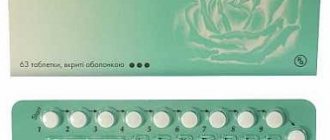The mechanism of action of birth control pills is as follows: each pill contains a dose of estrogen and progestogen, which are similar to natural ones, but not identical. Entering the body regularly, hormones provoke a decrease in the production of their own by inhibiting the synthesis of FSH and LH by the pituitary gland. As a result, the level of your own estrogens and gestagens decreases, and ovulation does not occur. This is the main contraceptive effect.
In addition to this, thickening of the cervical mucus and endometrial atrophy occur, as a result of which, in the event of fertilization, the fertilized egg cannot attach to the wall of the uterus.
While taking oral contraceptives, the severity of all symptoms of endometriosis decreases: pain goes away, the amount of discharge decreases, and spotting is no longer bothersome. Therefore, for some time it was believed that birth control pills were one of the options for treating endometriosis and preventing the progression of the disease.
However, recent research has shown that taking birth control pills for endometriosis is not only not recommended, but can also lead to progression of the disease. Indeed, the symptoms of the disease decrease while taking medications.
However, the estrogenic component they contain promotes the further growth of endometriotic lesions, as a result of which the overall course of the disease worsens. And after discontinuation, all symptoms return within a month or three.
However, there are some exceptions. Birth control pills may be prescribed for endometriosis in the following cases:
- At the initial stages in young girls, including to obtain a rebound effect - natural stimulation of ovulation after discontinuation of the drug.
- If oral contraceptives contain dienogest as a progestin component.
- If endometriosis is only suspected, but does not have significant clinical manifestations.
Rebound effect after discontinuation of a contraceptive drug
Research in recent years has established that as a treatment for endometriosis, the most effective drug after agonists and antagonists of gonadotropic hormones (they act at the level of the pituitary gland and hypothalamus) is Visanne based on dienogest .
When taking the medicine for 3-6 months, there is not only a decrease in the severity of all symptoms, but also a decrease in the number and size of endometrioid ectopia. And the effect persists for a long time after discontinuation of the medication.
When choosing birth control pills for the treatment of endometriosis, preference should be given to those containing dienogest. These are "Bonade", "Janine" and "Klayra" . It is believed that due to dienogest, foci of endometriosis will decrease, which will lead to regression of the disease, although not as intensely as with the single drug Visanne.
"Klayra" is a three-phase drug. The action is as close as possible to a woman’s natural cycle. It is believed that adaptation to such a medicine should go more smoothly. “Klayra” is also recommended for use by women after 35 years of age until the onset of menopause. You need to take it for at least 3 months.
"Bonade" (a complete analogue, produced by another) is a monophasic oral contraceptive. The package contains 21 tablets, after taking which you need to take a break for 7 days, during which the woman begins to experience menstrual-like discharge. Each tablet contains the same dose of estrogen (ethinyl estradiol 0.03 mg) and progestin (dienogest 2 mg).
During addiction to the drug, acyclic spotting is allowed to appear between the expected days of menstruation. Treatment should last for at least 3 months, and if necessary or desired, longer.
Treatment of endometriosis with contraceptives should only be prescribed by a doctor, taking into account the clinical form of the disease, its prevalence, as well as the woman’s constitution and preferences. For women after 35-40 years of age, preference is given to prescribing “Klaira”; for young women, especially those who have not given birth, “Zhanina” (“Bonade”).
For endometriosis, other methods of contraception can be used. To treat pathology and protect against pregnancy, the Mirena intrauterine system can be used. This is a special spiral that contains a microcontainer with a hormone (gestagen), which is released gradually and in doses over 5 years.
The use of popular oral contraceptives (Regulon, Jess, Yarina, Zoeli, Silhouette, Belara, vaginal ring NuvaRing and others) if the presence of endometriotic lesions has been established is inappropriate. This will lead to an improvement in the woman’s well-being, but will not stop the progression of the disease.
The use of a conventional IUD is not recommended for endometriosis , as this can provoke progression of the disease. Other methods of contraception (spermicidal vaginal tablets, interrupted sexual intercourse, condoms) do not affect the course of the disease, but only protect against pregnancy.
Other groups of hormonal drugs are also used to treat endometriosis, which do not provide a reliable contraceptive effect, so they cannot be called contraceptives:
- Gestagens: “Utrozhestan”, “Duphaston”, “Susten”. On the contrary, they favor pregnancy. Similar drugs “Novinet” and “Depo-Provera”, when used for a long time, can suppress ovulation and thus protect against pregnancy, but it is difficult to find out exactly when this happens. Taking Visanne also does not protect against pregnancy.
- Agonists and antagonists of gonadotropic hormones (Zoladex, Buserelin, Diferelin) usually lead to a lack of ovulation already in the 2nd month of use. However, fertility (the ability to conceive) is often restored immediately after the drug wears off. This is usually one month unless the next injection is given.
Considering that all of these drugs do not provide reliable protection against pregnancy, it is recommended to use additional methods of protection during treatment , since the effect of these drugs on the developing fetus has not been established, and teratogenic (defect-causing) effects cannot be ruled out.
When prescribing contraceptives for endometriosis , the doctor pursues several goals:
- reduce the severity of pain during sexual intercourse, during menstruation;
- eliminate prolonged spotting before and after menstruation;
- reduce the number of critical days and the volume of blood lost.
Impact on these factors leads to an improvement in a woman’s quality of life.
Read more in our article about birth control for endometriosis.
Endometriosis after 40 years, causes and consequences
According to medical statistics, this disease occurs in every second woman of childbearing age. Normally, the cells lining the inner wall of the uterus (endometrium) are eliminated from the body during menstruation. The pathology causes the growth of the endometrium; the rejected cells are carried throughout the body by the blood stream, settling on the walls of other organs of the genitourinary, digestive and even respiratory systems. There they form endometriotic lesions.
The reasons for this “wrong” behavior of endometrial cells are not fully understood. Most experts believe that the main factors in the development of endometriosis are:
- hormonal disorders;
- decreased general immunity;
- bad heredity;
- abortions.
It is after forty years, before the onset of menopause, that the hormonal status and immune defense of the female body change. The menstrual cycle is disrupted, increased estrogen production contributes to pathological growth of the inner layer of the uterus, and reduced immunity is unable to prevent the penetration of endometrial cells into the walls of other organs.
At this age, other causes of the disease may be added, for example, diabetes mellitus, thyroid pathologies, diseases of the cardiovascular system, and excess weight.
As endometriotic lesions grow on other pelvic organs and in the abdominal cavity, cysts and adhesions appear. These non-cancerous neoplasms affect the functioning of the body, causing certain symptoms:
- During menstruation, pain may appear in the lower abdomen or lumbar region;
- the duration of menstruation increases to 7-8 days;
- the menstrual cycle is disrupted;
- menstruation is accompanied by heavy bleeding;
- brown discharge is observed in between;
- Pain occurs during sexual intercourse.
Significant blood loss during a woman’s critical days can lead to the development of anemia. A low immune status of the body, combined with unfavorable environmental factors and an unhealthy lifestyle, according to experts, can lead to cancer of the reproductive organs. In 50% of cases, women of this age experience infertility.
Emergency contraception
Unprotected sexual intercourse, a torn condom, missing pills - a number of reasons requiring emergency assistance in contraception can be continued. In this case, medications containing high doses of hormones are taken - Postinor, Mifepristone, etc. The action of these contraceptives is aimed at stopping the ovulation process, changing the structure of the endometrium and rejecting the fertilized egg. But if up to 35 occasionally, no more than twice a year, a woman could turn to post-coital contraception, then upon reaching this age this method of protection is strictly prohibited. Excess hormones in drugs can provoke the formation of blood clots, to which women of this age are predisposed. This increases the risk of stroke and death. Women who smoke are at even greater risk.
After 35 years of age, the consequences of taking emergency contraception can be unpredictable
Drug treatment of endometriosis in premenopause
During the period when a woman's body is preparing for menopause, menstrual irregularities are normal. Therefore, the first signs of endometriosis are perceived by many as normal. Contact a gynecologist only if severe pain occurs, when treatment may not lead to a complete recovery. The symptoms of the initial phase of the disease are similar to those of endometritis, which also complicates the diagnosis.
If endometriosis is diagnosed as a result of a complete examination, the doctor prescribes treatment. Since the main cause of the disease is considered to be a hormonal imbalance, hormonal therapy is carried out in combination with painkillers and anti-inflammatory drugs.
What effect to expect
When prescribing contraceptives for endometriosis, the doctor pursues several goals at once, trying to choose the best ones from the entire arsenal. Namely:
- Reduce the severity of pain during sexual intercourse, during menstruation.
- Eliminate prolonged spotting before and after menstruation.
- Reduce the number of critical days and the volume of blood lost.
Impact on these factors leads to an improvement in a woman’s quality of life. By prescribing conventional contraceptive drugs, it is possible to achieve an improvement in a woman’s well-being, but only for the duration of treatment. The use of drugs based on dienogest is more effective and the results obtained last for some time.
And here is more information about what menstruation is like with Byzanne.
Contraceptives for endometriosis should be selected based on the stage of the disease, the woman’s complaints, and examination results. It is most rational to use medications containing dienogest (Bonade, Janine, Qlaira), as well as the Mirena IUD. When prescribing, it is necessary to take into account contraindications and possible side effects.
1. Hormonal drugs, possible consequences of taking them
With the onset of menopause, endometriosis in women, as experts note, often goes away. The production of estrogen decreases, the growth of the endometrium stops, and complete recovery occurs. Therefore, the task of hormone therapy in premenopause is to change the level of sex hormones to postmenopausal levels.
Sex hormones are produced in the ovaries. This process is regulated by the release of special substances by the hypothalamus and pituitary gland. Therefore, treatment for endometriosis with hormonal drugs is aimed at:
- direct changes in the level of hormones in the blood with the introduction of special medications;
- hormonal effects on ovarian function;
- regulation of the processes of hormone production by the pituitary gland and hypothalamus.
In accordance with these directions, several groups of hormonal drugs are used to treat the disease:
- Progestins or gestagens, acting similarly to progesterone, suppress the production of estrogen, and therefore the growth of the endometrium. These include Duphaston and Norkolut, available in tablet form, as well as Utrozhestan, which can be taken in tablet form and intramuscularly.
- Combined oral contraceptives contain one or more hormonal drugs. By increasing the level of hormones in the blood, they reduce the production of estrogen by the ovaries, due to which the growth of endometriosis lesions gradually stops. This group includes Janine, Marvelon, Femoden, Yarina, Silhouette and others. All are available in tablets.
- Hormonal agents that indirectly affect the functioning of the ovaries bring the body into a state of temporary menopause. The concentration of estrogen decreases and the growth of abnormal endometrial cells is suppressed. Medicines in this group include Diferelin, intended for intramuscular administration, Buserelin nasal spray, Zoladex for subcutaneous injection, Lucrin-depot - for subcutaneous and intramuscular administration.
- Oral contraceptives with minimal hormone content (so-called mini-pills). Their effectiveness is low, but they have anti-inflammatory and analgesic properties. Among them, the most popular are Charozetta, Ovret, Microlute and Micropar.
Only a specialist can determine the treatment strategy for endometriosis and choose the appropriate hormonal drug. This applies to all women of childbearing age, but especially those over forty.
Often the disease is accompanied by pathology of the mammary glands. Due to imbalance of hormones, mastopathy develops. In this case, hormone therapy is also carried out, progestins or mini-pills such as Visanne are used.
When prescribing hormones, it is necessary to inform the attending physician about the presence of concomitant diseases, since the use of these medications has a number of contraindications, which include:
- allergic reaction;
- exacerbation of chronic liver and kidney diseases;
- diabetes and hyperthyroidism;
- tendency to thrombosis;
- hypertension;
- uterine fibroids;
- oncological diseases.
Women who smoke are also at risk. Hormone therapy should be used with caution for cystic ovarian lesions.
Long-term use of hormones (4-6 months) often leads to negative consequences. The most common are:
- increased appetite and, as a result, increased body weight;
- swelling of the face and legs;
- blood clot formation;
- the appearance of acne;
- frequent migraines;
- depression.
The development of these unpleasant phenomena does not depend on the type of medications used. In addition, hormone therapy does not exclude the occurrence of relapses.
In the presence of concomitant diseases and to relieve pain, anti-inflammatory, painkillers, and antispasmodics are prescribed, that is, complex therapy is carried out.
Scheme for using contraceptives
For endometriosis, hormonal contraceptives are prescribed according to one of the following regimens:
- 21+7. Between cycles of 21 days there is a break for a week. At this time, menstrual-like bleeding occurs;
One of the regimens for taking hormonal contraceptives.
For endometriosis, a prolonged treatment regimen is more often used (63+7). It reduces the impact on the endometrium and reliably suppresses the growth of heterotopias.
Rules for taking contraceptives:
- The first tablet should be taken on the first day of menstruation - from the moment bleeding begins;
- All pills during the cycle must be taken at the same time;
- You should not skip taking pills. If missed, follow the instructions for the drug;
- Vomiting or diarrhea within 4 hours after taking a pill is equivalent to skipping it;
- Some medications (such as antibiotics) reduce the effectiveness of birth control pills. Additional means of contraception are needed - for example, condoms.
The course of therapy lasts from three months. This is the minimum period during which changes in the tissues of the reproductive organs can be tracked. If a woman is not planning a pregnancy, she can take contraceptives for as long as she likes - up to the age of natural menopause.
Hormone therapy is the basis of treatment for endometriosis. As an alternative to COCs, gonadotropin-releasing hormone agonists or progestins can be considered. You can’t do without hormones - only they suppress the growth of lesions and normalize the woman’s condition. Other remedies only relieve symptoms, but do not cure.
Comprehensive treatment of endometriosis
If concomitant diseases or allergic reactions prevent the use of hormones, the doctor prescribes therapy with non-hormonal anti-inflammatory drugs. It is not as effective, but it helps relieve symptoms of the disease for a long time. It is usually used in the initial stages of endometriosis.
Anti-inflammatory drugs that have an analgesic effect include Ibuprofen, Ketoprofen, Xefocam, Movalis; No-shpa, Spazmalgon, Maxigan, Halidor relieve spasmodic pain well. They can also be taken during hormone therapy.
The complex treatment regimen for endometriosis, regardless of whether hormones are used or not, includes several groups of drugs. Their task is to improve the general condition of a woman’s body, increase immunity, and normalize hormonal levels. Such remedies include:
- Endopherin, a protein substance that does not contain hormones. The medicine is used when hormone therapy is not possible. The composition includes a natural extract from cattle ovaries, which inhibits the growth of the endometrium and normalizes the menstrual cycle. Unfortunately, the drug is not registered in the Russian Federation, although positive treatment results have been described in the initial stages of the disease. As prescribed by a doctor, it can be used in complex therapy.
- Phytohormones are substances found in plants that are similar in molecular structure and action to human hormones. They are found in large quantities in soy, green tea, spinach, and broccoli. They have no contraindications and do not cause unpleasant symptoms even with long-term use. They normalize hormonal levels and the menstrual cycle, reduce bleeding, and relieve inflammation. Remens, made from black cohosh extract, and Inoclim, containing soybean phytohormones, have proven themselves well. This group also includes Cyclodinone, which contains an extract of the fruit of the common twig, which stabilizes the level of sex hormones.
- Immunomodulators are drugs that level the body’s immune status. It is recommended to use those that contain substances of biological origin. For example, Derinat drops are made from the DNA of sturgeon fish, Vilozen from the thymus of cattle, Immunal from Echinacea juice.
- Sedatives calm the nervous system, relieve tension, and improve sleep. For complex treatment, it is better to choose herbal-based medications, such as tinctures or tablets of valerian and motherwort, peony tincture, and preparations with St. John's wort extract (Negrustin).
- Tranquilizers are prescribed for those with a tendency to neurosis and anxiety, which often accompany endometriosis. To avoid addiction, they are used for a short time, avoiding potent drugs. The “softest” are Afobazol, Mebicar, Mexidol.
- Iron-containing preparations are necessary for the prevention of anemia that develops with menstrual irregularities and heavy bleeding. Preference is given to oral medications, which ensures better absorption of iron by the body. These include Ferroplex, Ferroceron or Aloe with iron (syrup).
- Vitamins improve metabolism, help improve immunity, and strengthen nerves. Therefore, “vitamin therapy” is part of the complex treatment of endometriosis. It is advisable to take vitamins A, C, D, E, group B.
Despite the fact that most of the listed remedies are freely sold in pharmacies, you cannot take them yourself, with the exception of sedatives of herbal origin. Only the attending physician, having assessed the degree of development of endometriosis, its symptoms, and concomitant diseases, prescribes medications for complex treatment.
If the initial phase of the disease is diagnosed, physical procedures are additionally recommended, for example, electrophoresis, reflexology, ultraviolet or laser radiation. In advanced stages of the disease, physiotherapy is contraindicated. In this case, surgical intervention is necessary.
Patient reviews
Reviews from patients confirm that drug treatment helps well at the initial stage of endometriosis development and loses its effectiveness in advanced cases.
Karina, 35 years old, Tver:
To treat endometriosis, the doctor prescribed me Visanne and recommended taking Ibuprofen to eliminate the inflammatory process. The gynecologist noticed positive changes from taking it a month later, during an examination. I want to say that the drug is good, but it is very difficult to tolerate, there are a lot of side effects.
Tatyana, 42 years old, Moscow:
To treat endometriosis, the doctor gave me the combined hormonal drug Logest, but after a month it only got worse. I went to another clinic and was examined, the disease continued to progress, and laser cauterization was prescribed. I am satisfied with the outcome, the reproductive organs are preserved, and reproductive function is preserved.
Vitalina, 32 years old, Pskov:
Endometriosis was discovered during an examination during the pregnancy planning stage, and I was very upset and scared. At that time, I did not know that with surgical intervention it is possible to preserve reproductive function. For treatment, I was prescribed several hormonal medications, I took them for six months, and after completing the course and recovery, I immediately became pregnant. My little son is already 5 months old.
It is possible to achieve success with drug treatment of endometriosis if the treatment regimen is determined by a qualified doctor. The basis of the effect is always hormonal pills. The drug group and dosage are determined individually, depending on the cause of the disease and its form. The patient should not count on a quick recovery; recovery takes about 1 year. If drug treatment is ineffective, surgery is necessary.
Unconventional methods of treating endometriosis
Traditional medicine methods involve the use of approved medications according to officially accepted regimens. Most medications have contraindications; long-term use leads to disruption of the functioning of other organs. Therapy does not come down to eliminating the causes of the disease, but only to eliminating the consequences.
Drug treatment is not always effective; good results can be obtained only in the initial phases of the disease; it often ends in the development of a chronic process. In such cases, alternative medicine comes to the rescue, considering the body as a whole. It is aimed at eliminating the causes of the disease.
Traditional medicine for endometriosis
The experience accumulated over hundreds of years in curing many diseases with the help of herbs and potions is still useful today. Decoctions, infusions, water and alcohol solutions, used for a long time, help cure chronic diseases, prevent the development of relapses, and improve overall health.
Herbal treatment (herbal medicine) is widely used in folk medicine for endometriosis in women after forty. For this purpose, medicinal plants are used that normalize hormone levels, increase immunity, reduce bleeding, and relieve pain. Nettle, St. John's wort, elecampane, plantain, calamus, knotweed, cinquefoil and others have similar properties. In pharmacies they are sold both individually and in the form of fees.
You can prepare the medicinal mixture yourself. To do this, mix 1 teaspoon of several herbs, pour 0.5 liters of boiling water, wrap and leave in a warm place for 2-3 hours. Use only enamel or glassware. You need to drink half a glass of the infusion before meals for a course of 3-4 weeks, then take a break for 10 days and repeat the course. After 2-3 courses, the menstrual cycle normalizes and bleeding decreases.
The most effective in the treatment of endometriosis are Red brush and Borovaya uterus, herbs from which decoctions, infusions and tinctures are prepared. Traditional medicine has also appreciated the unique properties of these plants. Preparations from the Red Brush (scientific name Rhodiola tetrapetalum) are capable of:
- regulate hormone levels;
- reduce bleeding;
- relieve spasms;
- normalize blood pressure;
- increase resistance to stress and adverse factors;
- improve the overall tone of the body.
This is a rare plant, therefore, in order to avoid counterfeits, it is recommended to buy in pharmacies only herbs collected in Altai, which guarantees its quality.
The hog uterus (Ortilia unilateral) is valued in gynecology due to the presence of important biological components, such as:
- phytohormones that suppress endometrial growth;
- anticoagulants that prevent thrombosis;
- vitamins that improve hematopoietic processes;
- bioflavonoids with a diuretic effect;
- microelements (manganese, zinc) that help improve immunity.
You can be treated with decoctions and infusions of these herbs together with prescribed medications.
For greater effectiveness, herbalists recommend drinking their infusions alternately according to the following scheme: 2 weeks taking Borovaya uterus - a week break - 2 weeks taking Red Brush. If no unpleasant symptoms (indigestion, headaches) appear, increase the intake of each remedy to 4 weeks. They take a two-week break. Treatment is continued for 6-8 months.
Water infusions of Borovaya uterus and Red brush are prepared and taken according to a simple scheme:
- Pour 2 tablespoons of chopped herbs into 0.5 liters of hot water (60-70°C);
- place in a boiling water bath for 15-20 minutes;
- cool, strain, add boiled water to 0.5 l;
- drink before meals, starting with a quarter glass, gradually increasing the intake to 0.5 glasses.
Use only glass or enamel dishes. The infusion is stored in a cool, dark place for no more than 3 days. For endometriosis, these drugs are also used for douching. The first procedures are carried out by diluting the infusion with water 1:1.
IMPORTANT! It is prohibited to boil or even pour Borovaya uterus and Red brush with boiling water. At 100°C, many useful substances are destroyed.
Alcohol or vodka tinctures of these herbs help with endometriosis. The method of preparation and use for them is the same:
- 2 tablespoons of crushed raw materials are poured into 0.5 liters of high-quality vodka;
- insist, shaking occasionally, in a dark place, Borovaya uterus for 10 days, Red brush for 3-4 weeks;
- take 20-40 drops with water 2-3 times a day, regardless of meals.
When using herbal folk remedies, you need to remember that any of them may have contraindications and cause side effects. To avoid these problems, you should consult your doctor before starting use.
Traditional medicine suggests treating endometriosis with other means, for example, using beekeeping products, cleansing the body with oils, juices, and water. Their effect, compared to conventional medications, is milder, but the effect of use is much lower. Therefore, traditional methods are best used as an addition to traditional therapy.
Other Treatment Practices for Endometriosis
When classical drugs for endometriosis in women are ineffective, they often resort to the methods of homeopathy and Ayurveda.
They are united by a common approach to all diseases: the body is a single whole, therefore it is necessary to treat not the diseased organ, but the person, using only natural remedies.
Homeopathic treatment
Homeopathy, being an alternative to traditional therapy, has developed its own rules:
- microscopic amounts of substances are used, such as plant extracts, metals, minerals, poisons;
- treatment is carried out with only one drug;
- It is prohibited to use homeopathic and traditional remedies at the same time.
During the initial examination, a homeopath studies not only the symptoms of the disease and the presence of other diseases, but also the patient’s character traits, his habits, and relationships with others. Therefore, people with different views, temperament, physique, with the same disease, as a rule, receive different treatment.
The effect of homeopathic medicines for endometriosis after 40 years is aimed at improving the general condition of a woman, increasing immunity, and relieving the main symptoms. Suitable for these purposes:
- Racemosa (snake root). It has anti-inflammatory, analgesic, anti-edematous and calming effects.
- Thuja is effective due to its diuretic effect, relieves pain, normalizes the menstrual cycle, and helps eliminate ovarian fibrous cysts.
- Nux Vomica reduces bleeding during menstruation, relieves cramps and headaches.
The main advantage of homeopathic medicines is their complete safety, which is achieved by minimal quantities of active ingredients. But you cannot take them on your own, without a homeopathic doctor’s prescription.
Pharmacies sell multicomponent homeopathic preparations - phytotherapeutic compositions, which can be recommended by a gynecologist for treatment; classical homeopathy does not use them. Such a remedy for endometriosis is the German “Galium-Hel”, which increases immunity.
Ayurvedic techniques
According to the teachings of Ayurveda, the main causes of endometriosis are hypothermia, accumulation of harmful substances and imbalance in the body.
To eliminate these negative effects, treatment regimens are used, including:
- the use of thermal procedures when cooling the body, such as a bath, self-massage of the lower back, thermal massage;
- removal of toxins with herbal infusions and Ayurvedic preparations, for example, Triphala guggul;
- harmonization of the internal state of the body with the help of special exercises and meditation.
There is no cure for endometriosis in Ayurveda; it is believed that restoration of energy balance will lead to a cure. Maximum attention is paid to the correct lifestyle, which includes physical activity, quality of nutrition, kind attitude towards people, managing one’s own anger and resentment.
The “magic” food of Ayurveda supporters is soy, because it contains a lot of phytohormones. It is also recommended to eat rice, carrots, apples, garlic more often, that is, foods that improve hormonal levels. To increase immunity, use aloe juice and a variety of spices. Herbs familiar to us, such as nettle, yarrow, St. John's wort, are recommended for douching.
Establishing harmony between body and spirit requires not only mental, but also physical effort from a person. The use of Ayurvedic asanas and meditation techniques, according to the doctrine, leads to renewal of the body and the cure of any chronic diseases, including endometriosis.
Treatment of the disease during premenopause is a complex and lengthy process. Success largely depends on the woman herself. Regular visits to the gynecologist, following his recommendations, taking the necessary medications, and a healthy lifestyle are the components of effective treatment. Supporters of unconventional methods should carefully select qualified specialists with whom they always maintain telephone or other contact. The main thing is not to self-medicate!
Video: endometriosis and fibroids - the cause is nutrition
ENDOMETRIOSIS and FIBROID - the cause is nutrition!
Video: panzerin suppositories for endometriosis
Panzerin suppositories for endometriosis
Video: how to treat endometriosis?
How to treat endometriosis?
conclusions
- Contraceptives are prescribed for mild to moderate endometriosis. They are used as the main method of therapy or in combination with surgical treatment;
- Combined oral contraceptives are prescribed according to the prolonged 63+7 regimen, but the standard 21+7 regimen is also allowed;
- Priority is given to dienogest-based products;
- Birth control pills relieve pain, normalize the menstrual cycle and improve the general condition of a woman. Drugs containing dienogest suppress the growth of lesions. The effect lasts only for the duration of treatment.
COCs for endometriosis are prescribed by a gynecologist after examining the patient. Do not try to choose a drug yourself - this risks developing complications!
source











